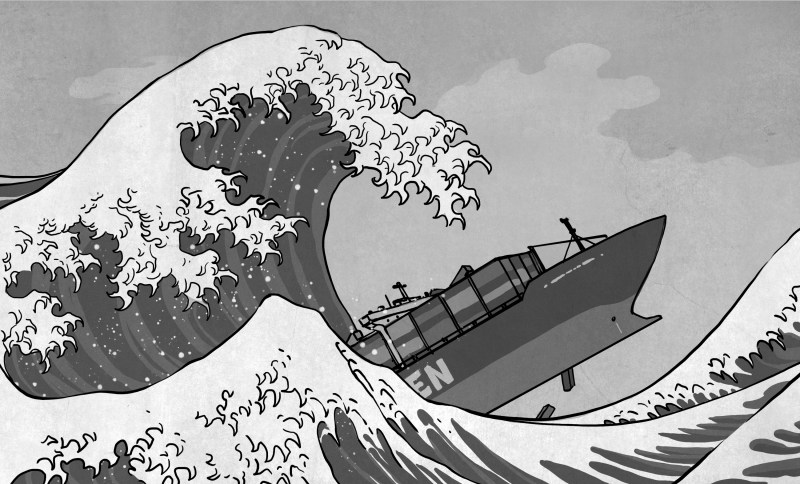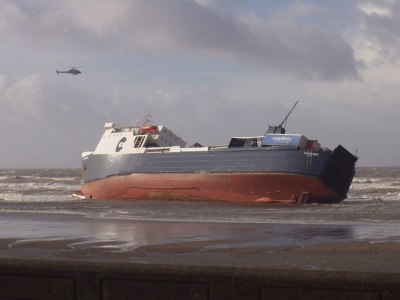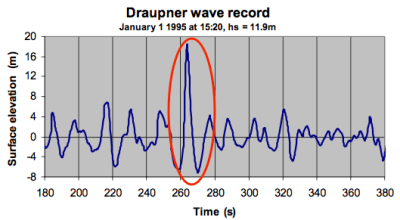
Stand by the shore and watch the waves roll in, and you’ll notice that most come in at roughly the same size. There’s a little variation, but the overwhelming majority don’t stand out from the crowd. On all but the stormiest of days, they have an almost soothing regularity about them.
Every so often though, out on the high seas, a rogue wave comes along. These abnormally large waves can strike with surprise, and are dangerous to even the largest of ships. Research is ongoing as to what creates these waves, and how they might be identified and tracked ahead of time.
Myth Becomes Reality

Stories of rogue waves have long been part of maritime folklore and legend. For centuries, sailors told tales of “walls of water” that would appear out on the open seas, dashing ships to pieces as the towering waves crashed over the vessel.
They’re not to be confused with tsunamis, either. Those are generally caused by the displacement of water from a volcano or earthquake or similar large disturbance. Tsunamis barely show up as more than a ripple in the ocean, only towering once they get close to breaking on the shore. Rogue waves are quite the opposite, standing at great height in open seas and posing a major danger to any ships or platforms caught in the path.
Despite many anecdotes of such phenomena, however, mainstream science was slow to accept the existence of rogue waves. Established models for wave creation and propagation simply couldn’t account for such behaviour. Thus, rogue waves remained largely ignored by the scientific literature. A handful of papers and texts looked into the idea of freakishly large waves, but the concept was seen as little more than a curious myth.

That all changed in 1995. The Draupner gas pipeline platform in the North Sea was struck by a rogue wave with a maximum wave height of a full 25.6 meters. It was a huge wave, well above the typical significant wave height of just 12 meters in the locality during typical conditions. The big break was that the Draupner platform was fitted with an accurate laser rangefinder wave recorder, which recorded the height of the wave accurately as it passed by. Thankfully, the platform only took minor damage, but the data captured went on to shake up oceanography for years to come.
The measurement of the Draupner wave completely changed the scientific consensus; there was now unarguable proof that rogue waves really existed. Research took off in earnest, with scientists quickly realizing that rogue waves fell outside of the typical Gaussian models used to predict wave height and activity.
By the early 2000s, scientists had determined that rogue waves weren’t obscure, 1-in-10,000 year events, either. By 2004, satellites of the European Space Agency were being used to spot rogue waves out in the ocean. Researchers found ten rogue waves over 25 meters in height after surveying a section of the South Atlantic for just three weeks.
In a relatively short time, science had gone from disbelieving in rogue waves to now finding them regularly showing up all over the world. It raised serious concerns, particularly in the world of ship design. Modern merchant vessels had traditionally been designed to withstand wave heights in the realm of 11 meters. Now, there’s a better understanding that waves in excess of 20 meters are not unexpected, and waves up to 30 meters are possible. It’s led calls to increase the minimum wave height that ships are intended to withstand, to give merchant vessels a greater chance at surviving an encounter with a rogue wave.
Hunting for an Answer
The modern definition of a rogue wave is a wave that is more than twice as high as the significant wave height. The significant wave height is determined by taking the mean of the top third of waves in a given sea state. Thus, a rogue wave stands out by being over twice as high as other tall waves in a given area.
Scientists hope to better understand what causes rogue waves to form. Rather than a single cause, current research suggests that a variety of different factors can come into play to generate a rogue wave.

Constructive interference is one of the simplest ways that a rogue wave can form. This is where separate waves travelling through the water come together and meet, wherein their peaks and troughs happen to line up, and the waves constructively interfere to become larger than before. Simulations have suggested that the angles at which these wave trains meet could play a significant role. One simulation showed that waves meeting at a 120 degree angle led to steep rogue waves being generated.
Interactions between wave swells and ocean currents are also suspected to be a way for rogue waves to form. This mechanism is thought to be at play off the coast of South Africa, where large rogue waves form in the region of the powerful Agulhas current. Where a swell travels in the opposite direction of an ocean current, the current is thought to have a focusing effect on the waves. The current slows the wave front, pushing subsequent waves closer together and raising the overall wave height.
Other explanations include non-linear phenomena, where one wave in a series of waves may suck energy from those around it, becoming larger in itself. This phenomena has been demonstrated in the lab successfully in water tank tests.
Research is ongoing into better predicting and understanding these wave events. A recent research paper has been published on trying to observe rogue waves in the field aiming to explore these causative effects. A wave buoy outfitted with inertial measurement systems and differential GPS for high accuracy was used to measure a rogue wave off the coast of Canada in 2020 through to 2021.
The study managed to capture data on a rogue wave of 17.6 m trough-to-crest height, in a sea state where the significant wave height was just 6.05 m by comparison. With a height ratio of 2.9 relative to the significant wave height, and a crest height 1.98 times higher, the study’s authors believe this to be the largest normalized rogue wave height thus far recorded. Notably the team did not discover evidence for non-linear effects in the generation of the rogue wave.
It’s likely it will take many years of further research and modelling before the rogue wave phenomena is truly understood. The efforts will only be hoped by better understanding, with more seafarers and researchers aware of rogue waves and thus better able to capture data on them when and where they occur.
Rogue Waves Are Mysterious And Big
Source: Manila Flash Report
0 Comments